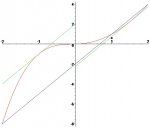… to find the absolute maximum and minimum, I should put the value of c in the according equation.
Is this a different question? Are you asking about the absolute max/min for g(x) on the interval [-2,2]?
I wonder if before you were thinking c = critical number because we use critical numbers to find absolute max/min values.
We evaluate the function at the endpoints of the interval and also at any critical numbers in the interval.
Critical numbers are values of x where g'(x) = 0 or g'(x) is undefined.
Your function g(x) has one critical number in [-2, 2]. Call this x-value C. (I use big C here, to show that it's different from that little c in the MVT). Now evaluate the function at the endpoints and at C.
g(-2) = ?
g(C) = ?
g(2) = ?
The largest value is absolute max, and the smallest is the absolute min, on [-2,2].
Regarding the original question, I found two values for little c (as shown in the MVT link that Dr. Peterson posted). He suggested you try again, using the interval [-2,2]. Did you finish that part?
These values c
1 and c
2 give x-locations where tangent lines are parallel to the secant line (the line connecting the endpoints of g's graph). The lines all have same slope. That's a graphical description of MVT. Another description is that c
1 and c
2 are values where function g's instantaneous rate of change is the same as its average rate of change (over the given interval).
In this graph, function g is shown in red, the secant line is shown in blue (its slope is the average rate of change), and tangent lines are shown in green (their slope is the instantaneous rate of change at x=c
1 and x=c
2). The lines are parallel, showing their slopes are the same.
CLICK GRAPH TO ENLARGE


